Choking happens when an object—often food—gets stuck in the throat and blocks the airway, making it difficult or impossible to breathe. If the blockage is partial, the person may be able to cough and clear it themselves. If it’s complete, they won’t be able to speak, breathe, or cough, and immediate action is needed.
Common causes of choking include eating too quickly, not chewing food properly, or swallowing small objects. Certain medical conditions, such as neurological disorders or muscular degeneration, can also increase the risk.
Signs and Symptoms of Choking

Recognising the signs of choking quickly can be life-saving.
- The person may instinctively clutch their throat.
- Difficulty breathing – They may struggle to inhale or exhale.
- Inability to speak or cough—If the airway is completely blocked, the casualty won’t be able to make any noise.
- Noisy breathing—If the airway is partially blocked, the patient may wheeze, gasp, or make whistling sounds.
- Distress and panic – They may appear anxious or frightened.
- Facial discolouration—Due to a lack of oxygen, their faces may turn red, pale, or even blue (cyanosis).
- Loss of consciousness – They may faint if the blockage isn’t cleared.
Treatment
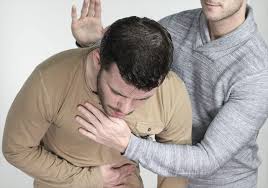
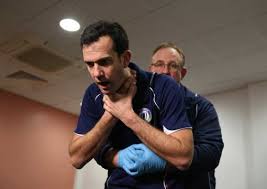
Managing a choking adult can be difficult; the casualty may lose consciousness very quickly after choking. Be prepared to start CPR, ensure help is requested, and if an AED is present, use it.
Choking Child

Choking is a subject that concerns many teachers, nursery staff and parents. The fact is that choking can be dealt with very quickly and effectively with some good knowledge and training.
The question that you should be asking is What do I do if the object does not come out?
This is when choking becomes complicated.
Recognition of Choking
Two types of choking need to be recognised and dealt with: partial and full blockage of the airways.

Partial Blocked Airway

The recognition features of a partial blockage are that the child will be:
- Grasping their throat
- Making gagging noises
- Redness of the face
- Eyes enlarging
- Eyes watering
- Coughing
- They may be able to speak
First Aid For Partial Blocked Airway
The method to unblock the partial blockage is
Straightforward:
- Remain calm, don’t panic
- Get the child to stand up
- Help them to stand up if needed
- Tell them to cough it up
- Pat the back lightly and encourage the child to cough up.
- Once removed, calm the child down and offer a drink.
Identify the object. Some objects may have sharp edges and could cause injury to the airway. Always be prepared for a partial blockage to become a full blockage. Do not be tempted to use tweezers, as these may force the object further down, or the child’s jaw may lock shut.
Choking Child- Fully Blocked Airway
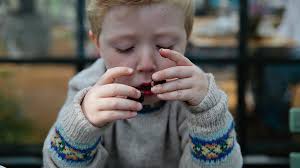
Recognise The Blockage
The recognition features of the full blockage
- No noise
- Grasping at the throat
- Shock (Pale, blue skin)
- Goes unconscious quickly
- Not breathing
SHOUT CHOKING CHILD
Let others know
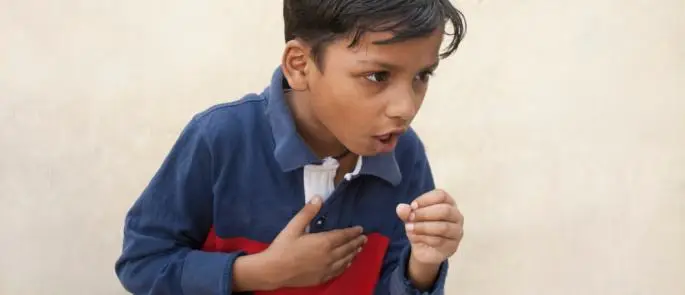
First Aid Step 1
Encourage the child to cough up.
Most children will be frightened that they cannot breathe, so shout ” COUGH IT UP” Repeatedly for a few seconds.
First Aid Step 2
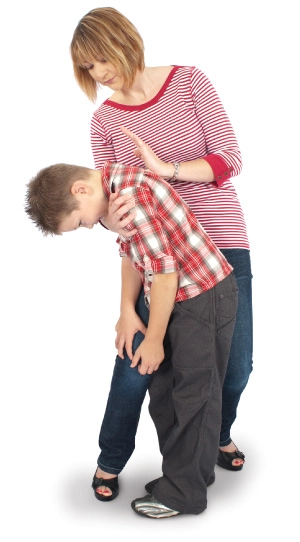
Back Slaps X5
Place one arm around the child’s body at chest height. You should have a firm grip on the child. Lean forward and strike the centre of the back with the heel of the hand five times. The strike should be in an upward motion between the shoulder blades. The aim is to send a vibration that will allow the throat to release the obstruction and the child to use their cough reflexes to dislodge the obstruction.
At this stage, you may have doubts about the outcome. If you have help, send them now to call for the emergency services.
NOT WORKING
Get Ready For Step 3
First Aid Step 3

Abdominal Thrusts X5
Place a clenched fist just under the
sternum, clasp your other hand over
the top of your fist. Pull both hands
and fist sharply inwards and upwards
Repeat the ” abdominal thrust” 5 times; the aim is to force the air from the lungs to force the obstruction out of the airways.
Repeat The Cycle 3 times, 5x Back slaps followed by 5x Abdominal thrust
IMPORTANT!
The moment you can no longer hold the child up to perform back slaps or abdominal thrusts.
“YOU MUST” place them on the floor and start CPR, the child is not breathing.
IMPORTANT QUESTION-
What do I do if I’m on my own?
You should do everything possible to remove the Object. Use the process taught above. The child will
If they become weak, they will go unconscious, they are not breathing and will quickly go into cardiac arrest.
What Next?
Give the child 5 good rescue breaths, mouth-to-mouth. Remember to pinch the child’s nose to prevent air from escaping. Should the chest rise and fall, this indicates you can pass air past the object. If there is no rise and fall, the airway is still fully blocked.
What Now?
Give the child another 30 compressions with one hand placed in the centre of the child’s chest between the nipple line. Push a little harder, as this may force the object up.
Continue With
2 more rescue breaths, mouth-to-mouth. Remember to pinch the child’s nose to prevent air from escaping. Followed by another 30 compressions.
If the airway does not clear, you must make the 999/112 call.
Important!
Once you have made the 999/112 call, return to the child and continue with CPR. Remember, a baby can be taken with you.
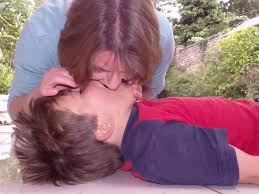

Why would I use this process?
This is a good question; the reality is that in 3 minutes, a child could have brain damage in 6-10 minutes. This brain damage may be irreversible. This process, when done on your own, may take a few minutes from choke to CPR. In the first few moments, there is an opportunity to release the object as the child’s body goes limp and relaxed. The object may be released. These are vital moments when the object can be released and the child resuscitated.
The harsh reality is that if you fail to remove the object from the child’s airways in a short period, the child may die.
Choking Baby

Dealing with a choking baby is difficult to deal with the same principle applies with choking child and baby i.e.
Partial Blockage
Full Blockage
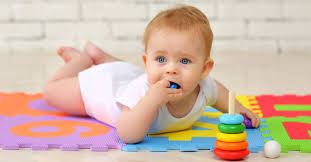
Recognition of a Choking Baby
Babies tend to gag on food. This is a normal process of baby reflexes; babies tend to swallow or spit the food out. Choking babies will remain silent with NO NOISE. Where a child can grip their throat and point, a baby cannot. Monitoring a baby, especially when they learn to pick up food and eat it is important.
Stop and Think! Just for a Moment
The reality of dealing with a choking child or baby is common and frightening, as mentioned before, it’s about doing the right procedures at the right time.
Difficulties arise when you are on your own. The drills we teach are simple and effective. What is important to remember is that when you are on your own, you must do everything possible to clear the baby’s airways.
The procedures taught on Life Lines courses take seconds to perform in real-life situations. Learn them; they may help you someday.
Choking is best taught as a practical subject and is taught in great detail at our paediatric Courses.

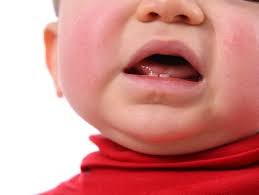
Recognition of a Partially Blocked Airway (Baby)
The recognition features of partial blockages are that they will be:
- Making gagging noises
- Redness of the face
- Eyes enlarging
- Eyes watering
- Coughing
- They may be able to cry
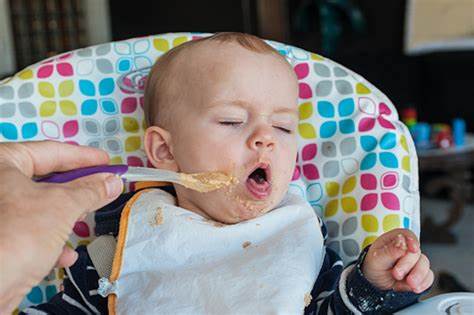
First Aid For Partially Blocked Airway(Baby)
Remember, in a partially blocked airway, the baby will be gagging, gasping and making noise. The method to unblock the partial blockage is straightforward:
- Remain calm, don’t panic
- Take the baby out of the high chair
- Lean the baby forward
- Allow them to spit food out
- Pat or rub the back lightly
- Once removed, calm the baby down and offer a drink.
Identify the object. Some objects may have sharp edges, which could injury the baby’s airway. Always be prepared for a Partial blockage to become a full blockage.
Choking Baby- Fully Blocked Airway (Newborn -12 months)
Recognise The Blockage
The recognition features of the full blockage:
- No noise
- Shock (Pale, blue skin)
- Goes unconscious quickly
- Not breathing
- Baby goes limp
SHOUT CHOKING BABY

First Aid Step 1
The baby is choking! Lift the baby up, look in its mouth to identify the object, and SIT DOWN
Place the baby across your thighs and tilt it’s forward. The Head must be lower than the rest of the body. Try to scrape the food or object out with your little finger.
Be careful not to force the food back, some food may come out “PAUSE” Wait for the “CRY.
Get Ready for Step 2
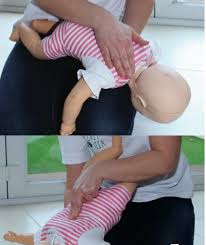
Choking Baby Step 2
Place the baby over the thighs of your legs.
The picture on the left gives a demonstration.
Your legs will support the baby. Ensure the baby’s chest is in contact with your thigh. Place a hand on the baby’s chin and extend the airway, lifting the head up.
Proceed with five back slaps. You must use reasonable force, pause between slaps, and listen for baby sounds. The aim is to dislodge the object; the baby could die if you don’t.
NOT WORKING
Get Ready For Step 3
Choking Baby Step 3 “CHEST THRUSTS” “NOT ABDOMINAL THRUSTS”
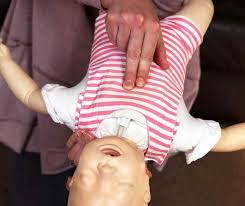
The chest thrust is used for the baby, i.e 0-12 months old.
Roll the baby over on your thigh “Do Not Flip” The aim is to allow gravity to assist in removing the food or object.
By flipping the baby, you may have missed a golden moment as the object was dislodging.
To perform the chest thrust, lay the baby across your thigh, this time on their back. Place 2 fingers in the centre of the baby’s chest, between the nipple line and draw your fingers back 3 inches.
Force the fingers into the baby’s chest, thrusting the fingers up the baby’s chest.
The aim is to use the air in the baby’s lungs to force the object out of the baby’s airway.
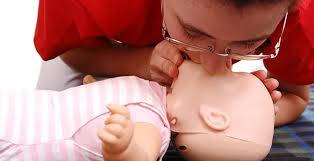
Repeat The Cycle 3 times 5x Back slaps followed by 5x Chest Thrust
IMPORTANT QUESTION-
What do I do if I’m on my own?
You should do everything possible to remove the Object. Use the process taught above. If they become weak, blue, and floppy, they have gone unconscious, are not breathing, and will quickly go into cardiac arrest.
What Next?
Give the baby 5 good rescue breaths, mouth-to-mouth and nose. Should the Chest rise and fall, this indicates you can pass air past the object. If there is no rise and fall, the airway is still fully blocked.
What Now?
Give the baby 30 compressions with two fingers placed in the centre of the baby’s chest between the nipple line. Push a little harder, as this may force the object up.
Continue With
2 more rescue breaths, mouth to mouth and nose. Followed by another 30 compressions.
If the airway does not clear, you must make the 999/112 call.
TAKE THE BABY WITH YOU
Once you have made the call, place the baby on the floor and continue to perform CPR
Ratio 2 breaths with 30 compressions
On the next page, we will look at CPR for Children and Babies.
